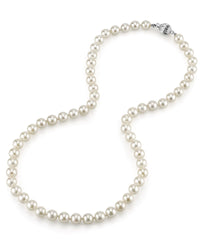
Japanese Akoya White Pearl Necklace, 6.5-7.0mm - AAA Quality
$1,540.00 Sale: $1,232.00

Tahitian pearls, dark grey orbs of great beauty and compelling mystique. Formed in the large, black-lipped Pinctada Margaritifera oyster of the South Seas, as pearl lovers, we are drawn to Tahitian pearls. This is not least because Tahitian pearls overtly challenge the very idea of pearls - demure, elegant, white gems. Commonly referred to as “black pearls,” these pearls come in a range of alluring colors – light and dark grey, silver and the most coveted, black– with a host of secondary colors creating magnificent, sometimes even rainbow-like, overtones.
The interesting thing about Tahitian pearls is that they are not farmed in Tahiti. Instead, it is in the pearl farms in French Polynesia where we find the most luscious of these pearls. The very definition of glamour and sophistication, wearing Tahitian pearls is a subtle way of saying “look at me.”

Tahitian Pearl Jewelry, Pearls of Joy
Many legends surround these beautiful pearls and their shell. According to one legend, Oro, an important god of the Polynesian pantheon, travelled to earth on his rainbow, which became the source of the multicolored iridescence of these pearls and their shell. Another, rather more romantic legend, suggests that Oro offered a black pearl to the princess of Bora Bora, as a token of his love for her.
The shell of the Pinctada Margaritifera oyster has long been coveted by the indigenous peoples of Polynesia for its iridescent mother-of-pearl. Traditionally, it was used as jewelled adornment. Silver grey carved discs of shell were worn as pendants and decorative embellishments on robes. But there is very little that is known about how these natural pearls were used by the people of Polynesia. A fascinating anecdote shared by George Kunz in his “The Book of The Pearl” tells of Queen Pomare, monarch of Tahiti in the early 1800s, playing marbles with black pearls.
With the arrival of European sailors to the Polynesian shores, the shells started being harvested in large quantities for use in jewelry, as buttons and for inlay work in furniture, in the West. Black pearls, accidents of nature, also began to be used in fine jewelry. However, such was the demand for the Pinctada Margaritifera mother-of-pearl that by the 1850s, overharvesting had led to a sharp decline in the population of these oysters.
A century later, in the 1950s, due to depletion of stock, oyster fishing was no longer the primary economic activity in much of French Polynesia. Instead coconut plantations had become an important source of income for the islands. But things started to change in the 1960s when French veterinarian Jean Marie Domard began studying pearl cultivation and with the help of Japanese pearl technicians, cultivated about 5000 Pinctada Margaritifera oysters. By 1964, the first pearl farm was established in French Polynesia by Hubert and Jacques Rosenthal, who belonged to Rosenthal jewelry family, known for their spectacular pearl jewels. This pearl farm became fully functional by 1966.

From left to right: Opera Length Tahitian Pearl Gem Quality Necklace, Tahitian Pearl 'Vera' Ring, Tahitian Pearl Multicolor Baroque Pearl Bracelet, Tahitian Pearl 'Daria' Earrings, Pearls of Joy
However, it wasn’t until the 1970s that black cultured pearls found international renown. In the mid 1970s, Salvador Assael, whose family had been in the gem and pearl business for centuries, partnered with French businessman Jean-Claude Brouillet to purchase the Tuamotu Atoll of Marutea, and set up a number of pearl farms there. It was the pearls from these farms that catapulted black or Tahitian pearls to the pinnacle of the gem and jewelry world. Assael showed a strand of gem-quality Tahitian pearls to his long-time friend, jeweler Harry Winston, who placed it front and centre of his 5th Avenue showroom window display. Within two weeks, the strand was sold. Very soon,many other luxury started featuring cultured Tahitian pearls in their jewelry pieces. In 1976, cultured Tahitian pearls were recognized by G.I.A. (Gemological Institute of America) as natural and unique gems.
In the mid 1980s, Robert Wan, a Polynesian national of Chinese heritage, entered the world of Tahitian pearl farming and within the next decade, was able to produce upwards of a million Tahitian pearls in a year. This completely changed the landscape of the jewelry and gem world, and especially the world of cultured pearls.

Tahitian Pearl Jewelry, Pearls of Joy
Tahitian pearls are the hallmark of luxury. Enigmatic and seductive, with their dark colors and uniquely bewitching overtones, they are quite unlike other pearls and colored gems. Therefore, it is surprising to discover that it was only in the 1970s that they found their way into the world of high and fine jewelry. Coveted by jewelry aficionados, set in statement jewelry pieces, Tahitian pearls remain one of the most valuable and desired gems in the world.
Featured Image: Tahitian Pearl Multicolor Gem Quality Necklace
Reema Farooqui is a content writer who loves pearls and pearl jewellery. You can find her on her website The Culture of Pearls or on Instagram at @thecultureofpearls